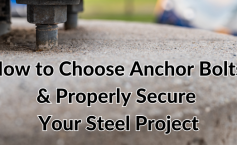Both 1040 and 1045 steels are popular at Capital Steel & Wire, and both have different chemical and mechanical characteristics. These also help determine different applications for both grades of steel.
Chemical Makeup
To see differences in chemical characteristics of 1040 and 1045 it is best to do a side by side comparrison.
| 1040 | 1045 | |
| Iron, Fe | 98.6-99% | 98.51-98.98% |
| Carbon, C | 0.40% | 0.45% |
| Manganese, Mn | 0.60-0.90% | 0.60-0.90% |
| Phosphorus, P (max) | 0.04% | 0.04% |
| Sulfur, S (max) | 0.05% | 0.05% |
Carbon content of both steel grades determines the last two digits of their grade number. The carbon content of 1040 steel is 0.40%, while 1045 has a carbon content of 0.45%. The first digit “1” identifies that they are both carbon steels, and the second digit “0” identifies that there were no modifications to the alloy.
Mechanical Properties
Whether steel is in the hot rolled or cold drawn form plays a major role in determining mechanical properties. The majority of 1040 and 1045 steel is purchased in cold drawn state, but we provided graphs of both hot rolled and cold drawn mechanical properties for both 1040 and 1045.
Here is a comparison chart of 1040 and 1045 hot rolled steel mechanical properties:
| 1040 Hot Rolled | 1045 Hot Rolled | |
| Tensile Strength | 76,000 psi | 82,000 psi |
| Yield Strength | 42,000 psi | 45,000 psi |
| Elongation in 2″ | 18% | 16% |
| Reduction in Area | 40% | 40% |
| Brinell Hardness | 149 | 163 |
Here is a comparison chart of 1040 and 1045 cold drawn steel mechanical properties:
| 1040 Cold Drawn | 1045 Cold Drawn | |
| Tensile Strength | 85,000 psi | 91,000 psi |
| Yield Strength | 71,000 psi | 77,000 psi |
| Elongation in 2″ | 12% | 12% |
| Reduction in Area | 35% | 35% |
| Brinell Hardness | 170 | 179 |
Real Life Applications
1045 has slightly increased tensile strength and yield strength numbers than 1040 as a result of a slightly higher carbon content. Also, as a result of higher carbon content, 1045 is not as easy to weld as 1040.





